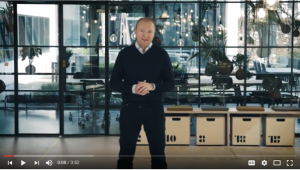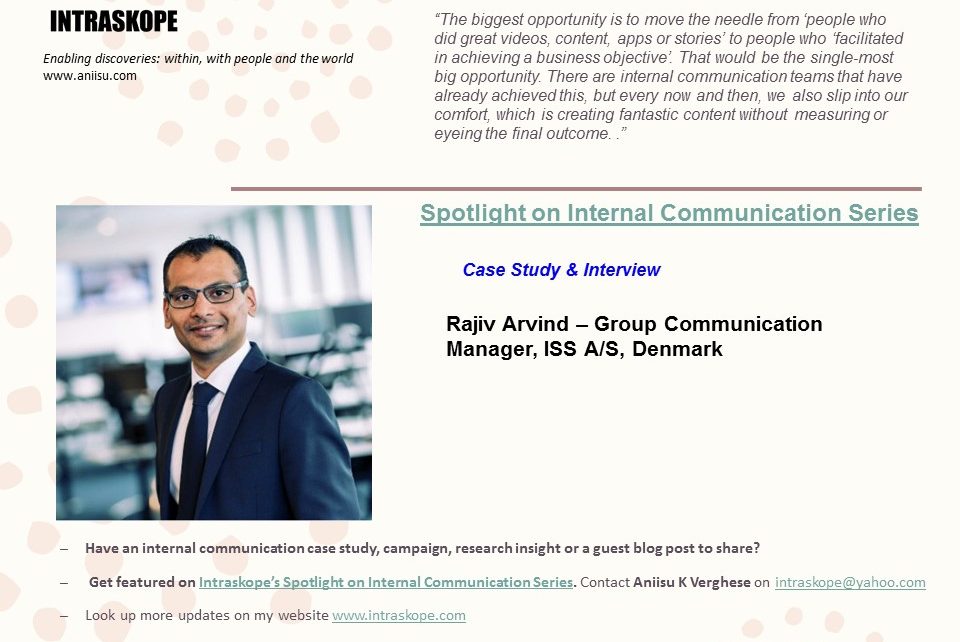Is it possible to improve customer satisifaction through internal communication? Can influencing leadership messaging result in better understanding of the company’s plans? How can internal communicators be perceived as ’value adders’ rather than implementers?
In this post, you will gain insights into these and other thoughts that may be on your mind. Intraskope’s Spotlight on Internal Communication Series features Rajiv Arvind, who manages internal communications at ISS World Services, one of the world’s largest leading facility services companies, operating in 74 countries, with close to half a million employees worldwide.
In the 19th edition of Intraskope’s Spotlight on Internal Communication Series, Rajiv shares, in a case study, his views on influencing leadership messages and improving the impact in companywide events.
Rajiv is a certified Communication Management Professional (CMP) by the Global Communication Certification Council (an IABC initiative) and a part of the EACD mentoring programme. He has close to 15 years of experience in internal communications, branding, customer communications and media & PR, working in B2B and B2C industries. Before entering the corporate world 12 years ago, he dabbled in advertising and copywriting and is currently responsible for internal communications globally at ISS World Services. ISS is headquartered in Copenhagen, Denmark and is one of the world’s leading facility services companies, operating in 74 countries, with close to half a million employees worldwide. Rajiv is a citizen of India and working in Denmark for close to 6 years. He has worked with leading global companies like Tata, Maersk, Carlsberg and ISS, giving him a perspective and understanding of the cultural differences, which is supremely important in communications.
Below you can read a fascinating case study about the role of communication in driving change, strategically advising leaders and aligning employees to the organization’s goals.
In an interview that follows the case study, Rajiv talks of his journey and how moving the needle on change management and engagement led to positive perceptions about internal communications as a function.
Case Study
Issue that needed addressing
- ISS’ leadership conference is a cultural institution in the global ISS organization that covers 74 countries. It is an annual summit that rejuvenates the organization and sets the strategic agenda for the coming year. The top 450 leaders from across the ISS globe are invited. In 2017, we focused not just on the leaders that were attending the conference, but challenged ourselves a bit. In a company of close to 500,000 people, how do we ensure that the relevant messages reach down the line into local country organizations and our customer sites? Can we drive these messages from the conference as far and wide into the organization as possible?
- In my experience, a lot of work and energy goes into creating content for leadership conferences. We wanted to ensure that we maximise the use of this content and leverage it even more within the organization, so that it not only lives for a longer time, but also has the legs to travel and be relevant for local country organizations.
- Each country conducts their own leadership conference for the management teams. The question was how do we ensure that we do not duplicate content and maintain a red thread in the messaging from the global leadership conference? In the process, can we save costs from a content creation perspective?
What was the intervention
A new team was managing the conference in 2017 and communications was bumped up the agenda. This was not only from a conference perspective, but also to ensure that we use the opportunity of an event of this scale to take the messages deeper into the organization. When we invest in a leadership conference, we wanted to ensure that the messages can travel further into the organization, because that is the only way we can positively impact business outcomes. This resulted in in a dedicated work-stream for communications.

Your/team’s role in crafting a solution
I was responsible for coming up with a plan for communicating pre, during and post the conference and supporting the messaging at the conference. The role was also to ensure that we drive these messages and content further into the organization post the conference.

The impact it had
Overall, the event improved the understanding of the organization’s goals. The event received 425 videos on how participants would ’invest in themselves’. The app received 40,393 sessions and 1,390 photos were shared. Also, the website received 7394 unique page views indicating the value employees felt about the event.
How it changed the way stakeholders perceived your team
Communications was involved because the conference project management team felt that it would add business value. We ensured that the messaging was consistent, but also linked and maintained the balance between being creative and ensuring strategy messages were clear and relevant to our audience for mass communication. So, after a successful conference and communication cascade, it only helped reaffirm how important it was to have communications on-board on this journey. As a proof point, while communications was involved only AFTER the theme was finalized for the conference in 2017; in 2018, communications is part of developing the storyline.

Your personal learning which other practitioners can benefit from
Push the bar. Leadership Conferences are held in most organizations and they have been held for years, but we need to keep pushing the bar, rather than follow set templates every year. That is the only way to ensure that we keep it relevant for the audience. It is not about ‘freshness’, but repeating the messages in an engaging way. We did a lot of new things at the conference, asking for video selfies from participants to set expectations about the conference, a mobile app for the conference, the content and tone of voice for the conference, a post conference website with curated content, to name a few.
Too often, we stick to what we know or have done, because we think that has worked before. But every once in a while, we need to get out of the comfort zone. Keep the content and platforms relevant to the audience and the changing times. It may not always work, but the good part is that you will always grow and be wiser for it.
What would you have done differently if you were to revisit the campaign?
One of the aims was to try and make the content travel deeper into the organization. What we did well was to curate the content and make it relevant for everybody by providing a platform that was easily accessible to everybody in the organization. What I would do differently is to continue reiterating the messages, the content and the importance of leveraging the content, even after the conference, to ensure we have consistency with our messaging throughout the global organization.
Interview
- What does internal communication mean to you?
When I started my career, I was really interested in advertising, because of the power, I thought then, to influence people to buy a certain product. When I interned in a large multi-national in Corporate Communications, I discovered an even more powerful way to sell products and services. The power was with all the passionate people who worked in the company. Through Internal Communications I had the opportunity to brand inside-out. Imagine when you have thousands of engaged, empowered employees who are brand ambassadors of the place they work and the products/services they provide. That is what excites and energies me about this field. Internal Communications to me is three things:
- Creating a sense of pride and purpose for our colleagues at the workplace
- Providing the larger picture and sharing their role or how they contribute to this
- Giving colleagues a voice – a voice to share stories, opinions and views and maybe even a platform to implement some of them
This in turn, creates ambassadors, engagement and loyalty. And I strongly believe that this is what creates happy customers. And usually, happy customers mean profitability.
- How is it practiced in your organization?
At ISS, the core purpose of Internal Communications is to build a common sense of purpose and pride amongst our employees. We do this by:
- Communicating the strategy better to the larger organization
- Business Partnering and communicating on key strategic projects
- Storytelling about celebrating our people and our must win battles
- Using our global leadership conference participants as key ambassadors to communicate the strategy
- Promoting and creating platforms for sharing best practice with the global communicator’s network
- Please share an example/campaign that you are personally proud of working on and that made a significant impact to your organization.
There are 2 cases from 2017, which I am specifically proud of.
- Communicating our strategy: We wanted to create a better understanding and engage the audience with our strategy execution and acceleration program called ‘GREAT’. But we wanted to reach out to all our employees, right down to our service professionals, and explain this program in a simple way on how we can all contribute, so that we can all go from good to GREAT. We launched three different formats of video to communicate the strategy – an elevator pitch from the CEO of what the strategy means (90 seconds), a storyboard about the strategy narrated by the CEO (detailed) and a mass-purpose film that could resonate with our staff who are not on a laptop day in and day out that could also be leveraged on social media. The mass-purpose film has been used widely on social media and internally to communicate the strategy. Furthermore, the film was converted in Danish, German, Spanish, Portuguese, French and Spanish by local organizations (voluntarily) as they found value in it and have been using it locally. YouTube views (English) show 1500 hits, but this has been used as a ‘native’ video on LinkedIn, Facebook and used locally by countries on their own YouTube channels as well. You can view the video here. The other strategy films are being used as part of training program to take this into the organization further.
- The Leadership Conference: The communication work-stream was handled successfully from pre, during to post conference and as a proof of value provided, I was involved in some of the additional elements related to the conference, than that was expected before. Many engaging elements were introduced in 2017 to take the conference wider, deeper into the organization like the post conference website along with the content, the mobile app for participants etc. 97.1% of the audience rated the ‘Built to travel’ website as something that they found engaging and useful for communication within their organization. 96.6% of the audience felt that they were enabled to share the learning from the conference to their teams.
- What is the biggest challenge you face while going about managing internal communication?
The balancing act between being strategic and tactical continues to be a challenge. On the one hand, the aim is to provide the ‘why’ of things, but requests like ‘videos, apps, stories’ continue to come in instead of discussing ‘what is the business objective of this project’, working through the target audience and messaging, before getting into the channels or tactics. But in my experience and to be fair, stakeholders are willing to listen and heed that advice and have that discussion. It’s about taking them on that journey with you rather than providing quick-fix solutions. Of course, there are times where we all must provide tactical and quick-fix results, but we should always have an eye on the long-term goals and work with a more strategic approach.
- What according to you is the biggest opportunity that internal communicators have?
To move the needle from ‘people who did great videos, content, apps or stories’ to people who ‘facilitated in achieving a business objective’. That would be the single-most big opportunity. There are internal communication teams that have already achieved this, but every now and then, we also slip into our comfort, which is creating fantastic content without measuring or eyeing the final outcome. A reality check or reflection or taking a step back, whatever you call it, is all what we need sometimes to reboot!
- How can internal communicators add more value to the business?
As I said before, by focusing on the business outcomes or objectives and not the outputs (number of stories, videos, number of views, etc.), we are raising the bar for ourselves.
- What is your advice for people who are keen to join internal communication and make a career? What skills must they have or develop?
You can have the Master’s and Bachelor’s degrees in communications and all that to go with it. It always helps. But one needs to be passionate about people and have two things handy always – empathy and listening skills. We are the bridge between the management teams and colleagues on the ground. And if you can bridge that bridge (to use a pun) then you are half way there. Another thing, which I tell myself as well is, keep yourself updated every day. Peers, communication forums, organizations like International Association of Business Communicators (IABC), European Association of Communication Directors (EACD), CIPR, they are all available at hand; not to mention social media. So, continue to develop your skills every day. And remember, technology is just a medium and not the solution. In communication, just as in any other profession, you never stop learning.
Missed previous stories from organizations featured on the Intraskope’s Spotlight on Internal Communication Series? Look them up here – Infosys, SOBHA Ltd., ICICI Securities, First Advantage, CK Birla Group, TVS Motors, GE, Suzlon, Tata Sons, Percept, Knight Frank, TCS Europe, Vedanta, Oxfam, Danske Bank, Diageo and Pandora.
Intraskope (www.aniisu.com) is the first blog on internal communications in India and among the earliest around the globe. Begun in 2006, the blog has over 530 posts on topics such as employee engagement, leadership communication and employee branding and receives thousands of visits from across the world. The blog, receives over 50,000 visits every month from over 50 countries globally, offers learning resources for practitioners, academicians, and students including industry workshops, research reports, and checklists. Intraskope has been featured on leading global internal communication forums like Simply-Communicate, IC Kollectif and International Association of Business Communicators. It is hosted by Aniisu K Verghese, author of Internal Communications – Insights, Practices & Models (Sage, 2012).
If you are an internal communication leader working in a firm or a not-for-profit anywhere in the world and have an internal communication case study, campaign, research insight or a guest blog post to share please contact me on [email protected]
You can also visit my website www.intraskope.com and You Tube channel to know more about my work




One thought on “Case Study & Interview | Rajiv Arvind | Why Engaged Employees Mean Happy Customers and The Role of Internal Communicators In Improving Connection”